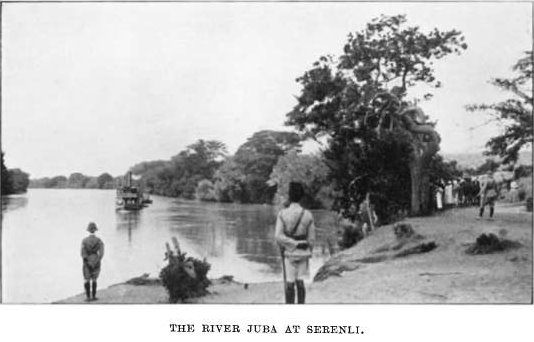Marehan Country was mentioned many times in History, let it be from the colonials or just ordinary travelers. Here below Marehan country was mentioned by Arnold Spencer Leese who was traveled many place in which Marehan country was one of them, he mentions it in his autobiography.
I spent several months at a forsaken spot called Serenli, 400 miles from the coast when you travelled on the river, and joined the expedition of Brigadier-General Hoskins when he went right on into the Marehan country to try and talk the natives there out of the necessity for a military expedition to make them behave. Whilst Hoskins did the talking, I was quietly surveying the routes for the future expedition if it were found unavoidable. Thus, the expedition could take place with the minimum camel-loss from Surra. However, Hoskins made no great impression upon the Marehan.
The Movement of Marehan to South Somalia
It is still assumed today that Sheikh Mohammad Abdille Hassan's rebellion between 1899 and 1920 in British Somaliland only made an impact in northern and central Somalia. In fact, however, the rebellion also influenced both the southernmost Somali and the administration of the Jubaland Province of the East Africa Protectorate. Anticipation that the rebellion would spread southwards, though unwarranted, led nevertheless to exaggerated fears and ultimately deterred further British involvement in that part of the Protectorate. These fears were not wholly unjustified, for the Jubaland Somali were inspired by Sheikh Mohammad's defiance of alien authority and probably wished to emulate him where possible. Furthermore, there was increasing contact between Mohammad Abdille Hassan's agents and the Juba region. However, it was the actual migration towards the Juba of Marehan who had fought with Sheikh Mohammad that had the most important impact on that area.
British East Africa and the Marehans
On 1st August 1914 half of 1 King’s African Rifles (“A”, “B”, “C” and “E” Companies) was in Jubaland in northeastern British East Africa. The companies were at Yonti, Gobwen and Serenli, military posts on the Juba River that separated Italian and British East Africa. Each company was about 100 rifles strong, these companies having the “foreign service” establishment as opposed to the other four companies in Nyasaland that had the “home service” establishment of 85 rifles.
In Jubaland companies from 1 KAR, 3 KAR and 4 KAR, had just finished campaigning on the Marehan Patrol under the command of Lt Col B.R. Graham, Commanding Officer of 3 KAR. The Marehan tribe had been causing concern & although Graham’s operation had not seen any serious fighting the Marehan had been temporarily pacified. In due course an African General Service Medal with the clasp: “East Africa 1913-14” was issued for service on the Marehan Patrol and 305 members of 1 KAR qualified for the award.
When war was declared “B” Company of 1 KAR, ( Captain G.J. Giffard) at Gobwen and Yonti, was brought back from Kismayu to Mombasa by steamer disembarking at Mombasa on 9th August. “B” Company moved up the Uganda Railway to Voi, and after a pause travelled on to Nairobi.
The British East Africa administration was reluctant to withdraw too many troops from Jubaland, apparently fearing the activities of Marehan raiders more than the activities of the Schutztruppe across the western border in German East Africa. [/u]
The struggle of power between Marehans and the British
In July 1912 Captain Fitzgerald's Askari were relieved at Serenli and they returned to Nairobi. For superstitious reasons "C" Company 3 KAR, which had lost the beri-beri victims, was disbanded and its men posted to "B" Company. "C" Company was not reformed. Between December 1913 and May 1914 a large operation named the Marehan Patrol was mounted against the Marehan tribe in Jubaland. Companies from 1 KAR (from Nyasaland, now named Malawi), 3 KAR and 4 KAR (from Uganda) took part but there was no decisive outcome. The Marehan took advantage of weak British garrisons in Jubaland during the Great War to overrun and capture Serenli in 1916, killing the British garrison commander and 35 of his Askari. A punitive expedition between July 1917 and March 1918 recaptured Serenli, tracked down the Marehan responsible for the British deaths in 1916 and hanged eight of the leading perpetrators. Over 4,200 Marehan camels and goats were captured and slaughtered as a reprisal against the malcontents in the tribe.
In June 1910 the British established a defensive post at Serenli, four miles north of Bardera. The local Marehan tribe was truculent and had to be treated as a threat, so the post was built on a small hill overlooking the river. An outer zareba (a perimeter hedge constructed from thorny bushes and branches) with machine-gun emplacements built into it surrounded the post.
A letter send to Brevet Major Lloyd-Jones from George Williams, who was at point in Marehan Country
Dear Sir, Just I receive a news (sic) that you have been fighting with Habashi and you
get wounded… this country now we are fighting with Marehan.
Source:
http://british-colonial-africa-from-187 ... CM_bar.pdf







